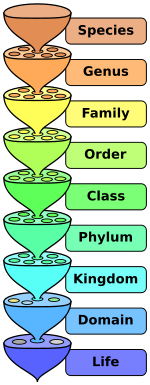| Image | Function | Reason | Links | ||||||||||||||||||||||||||||||||||
|---|---|---|---|---|---|---|---|---|---|---|---|---|---|---|---|---|---|---|---|---|---|---|---|---|---|---|---|---|---|---|---|---|---|---|---|---|---|
Cosmos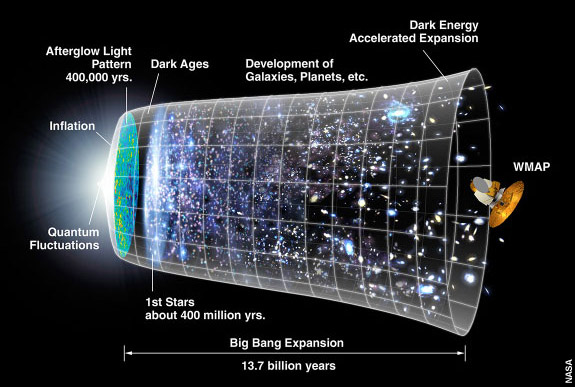 |
From simple to complex. From inorganic to organic. |
Creation of "viable" physics, i.e. strings that result in subatomic particles that result in atomic particles with the "right" mass and other factors of the physics "sweet spot." These aggregate into stars, where the heavier elements are formed. Star formation begets planets. Planets beget life. | Physics
as
evolution Beware that the infamous "Big Bang" may have been one of many "big flaps" in membrane theory. |
||||||||||||||||||||||||||||||||||
Strings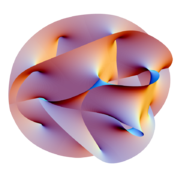 |
Differentiate - Certain string vibrations bring into existence subatomic particles. | Comply with physics. | The
Universe on a string Complexity - Visions of the Whole |
||||||||||||||||||||||||||||||||||
| Spontaneous self-organization | |||||||||||||||||||||||||||||||||||||
Subatomic Particles - E8
Symmetry in two dimensions (larger)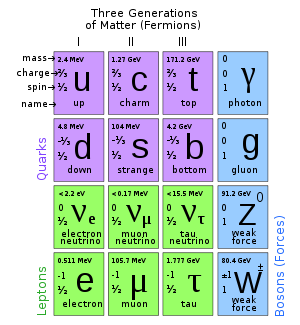 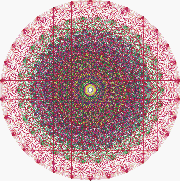 |
Aggregate to Differentiate - When exposed to high energy (temperature and pressure of stars) Subatomic Particles combine to make many more elements than there are Subatomic Particles. | Comply with physics. | Complexity Examples | ||||||||||||||||||||||||||||||||||
Elements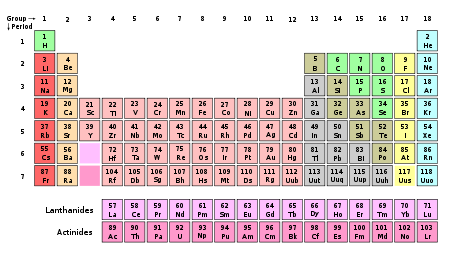 |
Aggregate to Differentiate - When exposed to high energy (temperature and pressure of stars) Subatomic Particles combine to make many more elements than there are Subatomic Particles. | Comply with physics. | Exploring Life's Origins, a Time line of Life's Evolution | ||||||||||||||||||||||||||||||||||
Molecules |
Selectively Aggregate to Differentiate - Some elements will combine with other elements into molecules, and others will not. The energy required for combination varies, but Element combinations require less energy than Subatomic Particle combinations. | Comply with physics. | Scale of life (move slider at bottom of diagram) |
||||||||||||||||||||||||||||||||||
Organic Molecules |
Selectively Aggregate to Differentiate - Organic molecules require little energy to combine into larger molecules like amino acids. | Comply with physics and geometry. | Supramolecules | ||||||||||||||||||||||||||||||||||
Amino Acids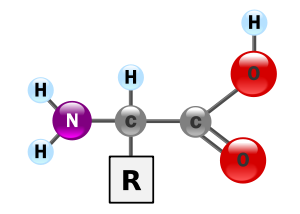 |
Selectively Aggregate to Differentiate - Organic molecule that contains both amine and carboxyl functional groups. Found in all life. Easily created with energy and a few elements. Found in comets. Likely endemic to the Universe. | Comply with physics and geometry. | The
astonishing promise of DNA folding Amino Acids - Life's Building Block Found in Comet |
||||||||||||||||||||||||||||||||||
Transcription Molecules - DNA and
RNA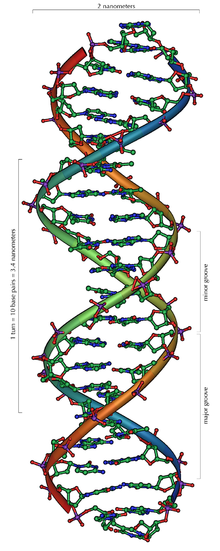 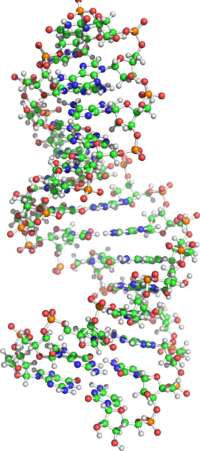 |
Transcribe - Amino acids link and fold to become DNA, RNA and messenger RNA, which serves as a template for the creation of proteins. | Symbiotic self-interest: Procreate by way of volunteer or hijacked (virus) cell machinery. | Nature and Evolution of Early Replicons (PDF, HTML, backup
PDF) Decoding the future with genomics |
||||||||||||||||||||||||||||||||||
Proteins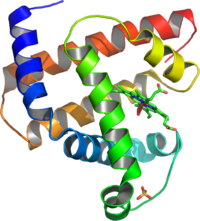 |
Work - Proteins are composed of amino acids arranged in a linear chain and joined together by peptide bonds between the carboxyl and amino groups of adjacent amino acid residues. Proteins provide structural and and mechanical functions to cells and catalyze biochemical reactions as enzymes. | Symbiotic self-interest: Procreate by being valuable to Organelle. | Molecular Machinery, A Tour of the Protein Data Bank | ||||||||||||||||||||||||||||||||||
Enzyme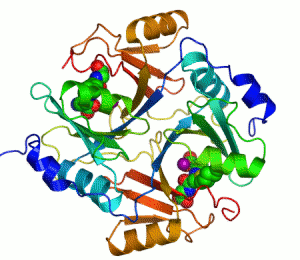 |
Improve efficiency - enzymes lower the activation energy for specific reactions (4,000), often dramatically increasing the reaction rate (millions of times faster than those of comparable un-catalyzed reactions). As with all catalysts, enzymes are not consumed by the reactions. | Symbiotic self-interest: Procreate by being valuable to Organelle. | Life, Living and Death | ||||||||||||||||||||||||||||||||||
Organelles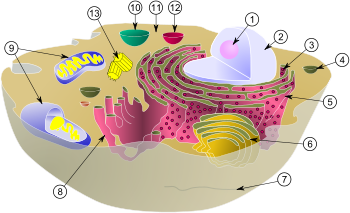 |
Specialize - A typical animal cell has many components. Within the cytoplasm, the major organelles and cellular structures include: (1) nucleolus (2) nucleus (3) ribosome (4) vesicle (5) rough endoplasmic reticulum (6) Golgi apparatus (7) cytoskeleton (8) smooth endoplasmic reticulum (9) mitochondria (10) vacuole (11) cytosol (12) lysosome (13) centriole. |
Symbiotic self-interest: Procreate by being valuable to Cell. | Bi 1 Syllabus - a wealth of information and graphics | ||||||||||||||||||||||||||||||||||
| The purpose of all life is procreation. To that end, life must acquire nutrients and in some cases energy (light). | |||||||||||||||||||||||||||||||||||||
Cells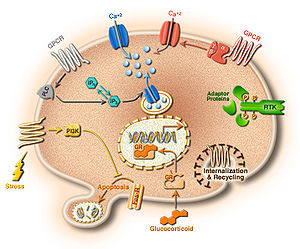 |
Live - When specialized molecules organize within a protective membrane, they are called a Cell. Membranes protect their contents while allowing nutrients to enter and waste to escape. | Self-interest: Obtain necessities of life in order to procreate by division. | Life and other self-organizing systems
counter
entropy. Fantastic voyage inside a cell |
||||||||||||||||||||||||||||||||||
| Mobility enables hunt and escape | |||||||||||||||||||||||||||||||||||||
Prokaryotic Cell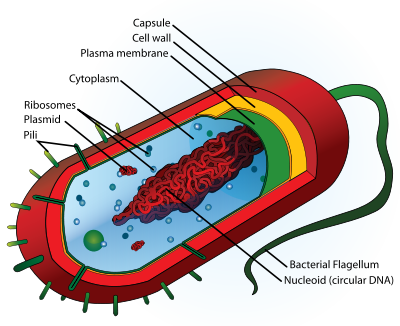 |
Live independently - Prokaryotic cells lack a cell nucleus (karyon), or any other membrane-bound organelles. May alter DNA to adapt to changing environment. | Symbiotic self-interest: Obtain necessities of life in order to procreate by division. May coordinate with similar cells in neighborhood. | Discovering
bacteria's amazing communication system Sperm originated 600 million years ago |
||||||||||||||||||||||||||||||||||
| Protection in numbers | |||||||||||||||||||||||||||||||||||||
Cell Colonies - Algae |
Live dependently - Eukaryotic cells cooperate in colonies. |
Symbiotic self-interest: Obtain necessities of life by way of colony in order to procreate by division. Reorganize to adapt (floating algae reaching to bottom to retrieve food). | May chemically communicate as above and chemically defend territory of colony. | ||||||||||||||||||||||||||||||||||
| Protection within others | |||||||||||||||||||||||||||||||||||||
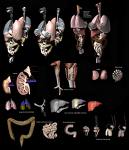 Organs (large
image) Organs (large
image) |
Specialize and live dependently - Organized cell colonies perform specific functions. | Symbiotic self-interest: Obtain necessities of life by way of species in order to procreate by being valuable to species. | Evolution is driven by gene projection. See Principles of Evolution, Ecology and Behavior audio or video. | ||||||||||||||||||||||||||||||||||
| Protection in numbers or with others, or predation with others | |||||||||||||||||||||||||||||||||||||
|
Specialize and live independently or as member of pack, pod, flock, hive, colony, etc. - Organization of organized cell colonies perform many functions. | Symbiotic self-interest: Obtain necessities of life by way of predation or being valuable to group in order to procreate by asexual or sexual reproduction. | Each species exhibits many of the
characteristics
of humans. |
||||||||||||||||||||||||||||||||||
| From Simplicity to Complexity | |||||||||||||||||||||||||||||||||||||
Human
-
origin, menstrual cycle, sex
and sexuality, development
in womb primates and money, unusual gene, realities. Humans are not
blank slates to mold into perfect humans, or equalize with
taxes and regulations, which if taken to its logical conclusion would
require superior athletes to wear weights. Most are affraid of spiders,
snakes, large animals, deep water, strangers, heights, humiliation and
eating home alone thanks to evolutionary history. primates and money, unusual gene, realities. Humans are not
blank slates to mold into perfect humans, or equalize with
taxes and regulations, which if taken to its logical conclusion would
require superior athletes to wear weights. Most are affraid of spiders,
snakes, large animals, deep water, strangers, heights, humiliation and
eating home alone thanks to evolutionary history.Life, living and death. |
Generalize to survive as hunter-gatherer - Bipedal species considered to be the most advanced on planet Earth. Derived from Sahara Sand People ancestors after near extinction. Only species to retain tools. Others make and discard tools. | Rational self-interest: Obtain necessities of life (property) by way of predation in order to procreate by sexual reproduction to increase adaptability. Theft of necessities is same as theft of life. | Own self and its limited means to obtain and defend property in order to facilitate gene propagation. | ||||||||||||||||||||||||||||||||||
| Organized by age or strength | |||||||||||||||||||||||||||||||||||||
Human family - relationships,
crying |
Specialize as hunter or gatherer - Two to four generations of the same genetic line living together. | Rational self-interest: Individuals obtain necessities of life by way of predation and cooperation in order to procreate. Theft of necessities threatens life. | Own self and additional means to obtain and defend property in cooperation with mate, progeny and perhaps extended family in order to facilitate gene propagation. | ||||||||||||||||||||||||||||||||||
| Organized by age, strength or consent | |||||||||||||||||||||||||||||||||||||
Human tribe - mutual
aide, ethics, morality , charity,
trust, size
and the unethical |
Specialize as hunter, gatherer, builder, tool maker, medicinal expert, counselor, arbitrator, leader, etc., and trade products and services - Multiple families living together. Usually related. Sometimes mobile. | Rational self-interest: Individuals obtain necessities of life by way of trade in order to procreate. Theft of necessities threatens life. | Own self and additional means to obtain and defend property in cooperation with other families in order to facilitate gene propagation. If nomadic, carry physical property, but may defend territory. If farming, defend static property. | ||||||||||||||||||||||||||||||||||
Human evolution has not caught up with two changes in human behavior. The first is sanitation. The human immune system has not universally adapted to the elimination of parasites, which suppress the immune system, so autoimmune disease is prevalent were sanitation prevails.
The second is emote control. I call it the tribal imperative. To project their genes, humans joined tribes where mates and protection could be had. This living arrangement has been dominant for so long that human brains evolved to experience pleasure when a member defends the tribe or attacks a competing tribe verbally or otherwise: my tribe right or wrong.
Humans are now members of multiple tribes like fraternities, sororities, religions, gangs, unions, political organizations, cities, counties, states and nations. The tribal imperative can make any membership exclusive, mean and violent, particularly when the tribal leader is Machiavellian. The destructiveness of tribal wars has been and remains immense.
In a world in which trade is becoming global and religion is being replaced by reason, tribes are not only useless, but dangerous to their members. As evidenced by Libertopia and other efforts, many humans have evolved beyond the tribal imperative. Making humans aware of their emote control will help the remainder avoid tribe membership and the authoritarian behavior associated with it.
Humans don't need to be led. They spontaneously organize to trade and specialize to increase their wealth (leisure, tools, food and other assets). They engage in benevoelent reciprocity. They need neither government nor religion. For more, see Voluntary Society.
Promote
and donate ![]() to
NaturalOrder.info
to
NaturalOrder.info
| Contact |
